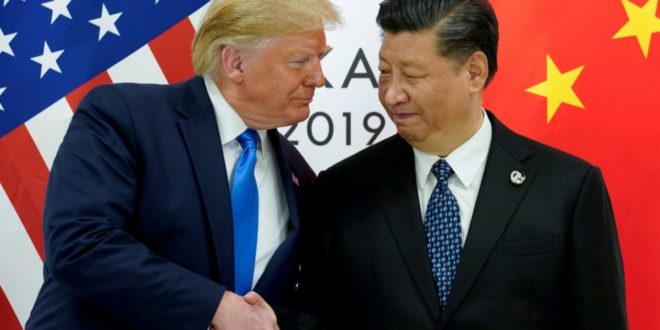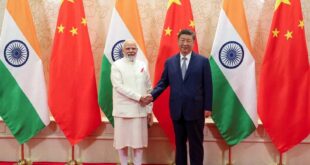Giancarlo Elia Valori
In principle it is not political choices that generate strategic doctrines. The opposite is true, if anything.
In the case of China, for example, it is very useful to study the evolution of recent strategic assumption and the most current military doctrines so as to later analyse political and even ideological changes.
Hence, which are China’s future and preferential battlefields? Which are the threats that the Chinese decision-makers regard as primary and what is their origin? What wars will China wage and fight? Indeed, inter alia, a strategic doctrine also answers these questions.
First and foremost, China’s military leadership has shifted the centre of gravity of its defence activities from the terrestrial centre of the country to the peripheries, hence mainly to the coasts and, ultimately, to China’s regional seas.
During the Cold War, China had adopted a defensive “all-out war”.
Currently the Chinese doctrine mainly concerns regional and limited wars, restrained both in time and space and in the use of force.
This means that currently China has not yet vast global interests to defend with a war. It will soon have them, however.
Moreover, currently the Chinese political and military decision-makers do not believe that – in the not too distant future – China will be involved in a global sea or territorial war.
The People’s Liberation Army (PLA) has a full monopoly of force in China.
Moreover, the PLA does not depend directly on the Ministry of Defence, but only on the Communist Party of China (CPC).
The PLA’s high-ranking officers report directly to the CPC’s Central Military Commission and not to other entities. Hence they take orders only from it. The PLA’s Commander-in-Chief is the General Secretary of the CPC; the Defence Minister reports only to the State Council and the Central Military Commission is only a very powerful body of the CPC.
With specific reference to military spending, the latest data reports a PLA’s annual cost of 250 billion U.S. dollars while, for example, the U.S. military budget amounts to 649 billion U.S. dollars, again based on the latest data available.
The Chinese ground forces consist of 975,000 units, while the Navy of 240,000 and the Air Force of 395,000 units. The Strategic Missile Force uses 100,000 units, while the Strategic Support Force finally operates with 175,000 soldiers.
Other unspecified tasks and functions are performed by 150,000 soldiers and officers.
As to materials used and weapons – which are a strategic indication and not just a mere information item – the PLA has 70 intercontinental ballistic missiles and 162 bombers; 3,860 armoured combat vehicles for infantry; 6,740 tanks and 13,420 artillery pieces; 57 missiles for submarine launch; 1 aircraft carrier, as well as 82 frigates and cruisers; 4 amphibious ships; 1,966 tactical aircraft; 246 attack helicopters and, finally, 77 military satellites.
So far the PLA has deeply studied the example of the U.S. war in Iraq and hence of the Revolution in Military Affairs (RMA).
This means a war fought above all with advanced technologies, communication networks and particularly with the highest-precision weapons and information technology.
Until the RMA adoption, China relied above all on the clear numerical superiority of its ground forces.
In other words, the Chinese military doctrine was based on the fight against a land invasion or an occupation but, after the Gulf War and the Iraqi war waged and led by the United States, China began to reduce the size of its ground forces so as to focus on more technologically advanced and better trained Forces.
Another key factor of Chinese military modernization has been Taiwan’s political status.
During the 1997 crisis, in fact, China did not succeed in discovering the way and extent of U.S. military engagement in the region.
It was after this failure that China began to produce anti-ship missiles, medium range ballistic missiles, A2 anti-ship missiles and other anti-access-area denial weapons, as well as cyber- and anti-satellite weapons.
As a whole, the People’s Republic of China has developed four military doctrines since 1949.
The doctrines developed before 1993, however, were all centred on the Maoist concept of “People’s War”, i.e. the “long-term People’s War”.
It was mainly based on maintaining the support of civilian population for the Armed Forces and on combining the efforts of the working class and of the “Red Army” led by the CPC.
The strategic goal of the “People’s War” was to force enemies to enter China’s large central area, where they would be besieged and then defeated, again by the combined effect of the working class and the Red Army.
In essence, the People’s War was aimed at being prolonged as much as possible and hence wearing and tearing the attackers.
Moreover, again according to Mao Zedong, the “long-term war” was based on three phases: strategic retreat, strategic stalemate and strategic counter-offensive.
With a view to completing these three phases, three types of Forces were needed: the regular army, the local forces and the guerrilla warfare forces.
However, there is no theory of political warfare – also outside Marxism – which does not envisage guerrilla warfare.
Towards the end of the Cold War, in 1980 China adopted the concept of the “People’s War under Modern Conditions”.
Again with the label of the Maoist “People’s War”, a war of defence was envisaged at various levels, which were already active at the borders, as well as far more offensive operations than those envisaged by the old “People’s War”.
In 1993 – almost at the end of the Cold War, in which Mao Zedong never believed – China adopted a new doctrine, called “Winning Local Wars under High-Tech Conditions”.
While initially the PLA was thinking about a war of defence against a land invasion, in the case of that doctrine the Chinese decision-makers imagined a peripheral war in high-tech conditions.
In other words, a defensive war against an attack by Taiwan, Japan, the United States or their regional allies.
And by the Russian Federation, as well. The Chinese doctrine was no longer defensive, as it even suggested a first strike, including a nuclear one, to immediately provide China with an advantage over the attacker.
The key concepts of the 1993 doctrine were the following: the “strategic frontier”, i.e. the limit beyond which you react, even with a nuclear salvo; “strategic deterrence”, which occurs when the enemy knows how China will react; “victory achieved through elite troops”, well beyond the old link between workers and the Red Army; “taking the initiative by striking first”; “victory over inferiority through superiority” – obviously of forces – and finally “quick battles to force quick resolution”.
A huge anthropological and cultural transformation, compared to the CPC’s political and military tradition.
No longer war of attrition, but quick war not designed to annihilate the enemy. Then strategic deterrence is considered, i.e. the use of nuclear weapons, as well as the new role – certainly scarcely “Maoist” and scarcely “people-based” – of the elite troops.
For Mao Zedong, at the core there was the “human sea” of his “People’s War”, not certainly the inequality between special forces and the rest of troops.
Moreover, there was another innovative aspect in the 1993 doctrine: the importance attached by China’s military decision-makers to the joint operations in its peripheries.
Reading between the lines, the CPC’s message was that, with the 1993 doctrine, China could solve the conflicts with its neighbouring countries by force.
The 2004 doctrine was called “Winning Local Wars with Informatised Warfare”.
The core of the issue was “IT and computerization”, which replaced the more generic term used in the 1993 doctrine of “High-Tech Conditions”.
Besides underlining again the importance of joint operations, as in 1993, the 2004 doctrine highlighted the consistent, orderly and stable flow of information between the various command and control centres and the military operating on the battlefield.
Therefore, since 2004 the core of the Chinese military reform has become the creation of a powerful command, control, communications, computers, intelligence and surveillance network (C4ISR).
The scenarios envisaged for the future war included, above all, the assault on the islands and the blockade of the islands, as well as counter-attack campaigns in border areas.
Finally, there is also a new Chinese military doctrine, which is largely still operational.
Released in 2014, it is called “Winning the Informatised Local Wars”.
The new Chinese “active defence” is based on it.
Although not radically changing the previous theories, the 2014 doctrine underlines the fundamental role of flexibility, mobility, joint operations, information dominance and precision raids.
The strategic direction remains the usual one: South-East Asia and Taiwan, i.e. China, tell us – between the lines – that a future and probable conflict for Taiwan will also involve the United States.
Furthermore, the 2014 doctrine carefully sets the issue of Military Operations Other Than War (MOOTV), such as rescue operations; counter-terrorism; maintaining political and social stability; protection of rights and interests; peacekeeping activities and international humanitarian assistance.
The Chinese PLA also distinguishes between MOOTW and Preparation for Military Struggle (PMS).
Therefore, incidentally, the primary goal is the war for conquering Taiwan, but the PLA is also preparing for regional wars in the South China Sea and Southeast Asia, while the current doctrine, from 2014 onwards, is a military theory linked to the solution of a “high-intensity conflict”.
The Chinese planners’ idea is a “war for the destruction of systems”, as was the case during the Gulf War in 1991 or the Kosovo one in 1999.
China currently implements the Effect Based Operation (EBO) criterion that the United States began to use in the mid-1990s.
The “war of systems” means that whoever wins paralyzes the enemies’ “system of systems”.
However, what would the United States do if it waged war against China? Most likely, it would start with operations on the Southern coast, with a view to decimating the Chinese Navy.
This would be followed by a U.S. attack against the Chinese command and control networks to prevent the PLA from striking back immediately.
In all likelihood, China would respond by using its artificial islands in the South China Sea and initially relying on information superiority, which would be followed by a joint operation against the U.S. fleet and later by a joint attack on one or many U.S. bases in the South China Sea.
GIANCARLO ELIA VALORI
Honorable de l’Académie des Sciences de l’Institut de France
President of International World Group
 Geostrategic Media Political Commentary, Analysis, Security, Defense
Geostrategic Media Political Commentary, Analysis, Security, Defense





